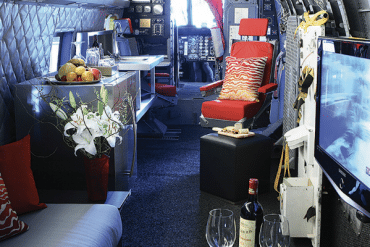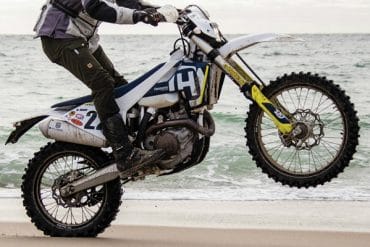 All at once, it is the most prolific and potentially dangerous fishing spot off Nantucket. Located just outside Madaket Harbor, a horseshoe shaped sandbar acts as the doorstep to the Atlantic Ocean, holding big fish, but also big waves. For those in the know, this stretch of water is the Bonito Bar. Every August, on the incoming tide, boats stream out of the harbor headed for this legendary spot. Before they can get there, however, they need to navigate through a breaker zone that can quickly put captain and crew at the mercy of the sea. Back in 2008, two fishermen were on the Bonito Bar casting into the rip at sunset when a wave knocked them both into the water. The boat was still in gear and left the men bobbing in the churning Atlantic. Thankfully, they were able to swim to shore with the incoming tide. As for the fate of their boat: Nearly four years later it washed up on the shores of Spain.
All at once, it is the most prolific and potentially dangerous fishing spot off Nantucket. Located just outside Madaket Harbor, a horseshoe shaped sandbar acts as the doorstep to the Atlantic Ocean, holding big fish, but also big waves. For those in the know, this stretch of water is the Bonito Bar. Every August, on the incoming tide, boats stream out of the harbor headed for this legendary spot. Before they can get there, however, they need to navigate through a breaker zone that can quickly put captain and crew at the mercy of the sea. Back in 2008, two fishermen were on the Bonito Bar casting into the rip at sunset when a wave knocked them both into the water. The boat was still in gear and left the men bobbing in the churning Atlantic. Thankfully, they were able to swim to shore with the incoming tide. As for the fate of their boat: Nearly four years later it washed up on the shores of Spain.
Captains call it “the opening,” “the cut,” the channel between Smith Point and Tuckernuck Island that serves as the western entrance to the Atlantic and the passageway to the Bonito Bar. Every captain in Madaket has a story about the opening. Mine first came when I was just a mate. The captain and I were leaving Madaket Harbor with two clients, heading west for the bar. The sets were rolling in as they usually did, big thick swells encroaching from the depths offshore, and then standing up over the shallows and avalanching into white water.
We idled just outside the opening and watched the sets roll through. Knowing the waves’ cadence is crucial; it tells you when to go, when to wait and when to pack it up and head back to the dock. The waves can be as tall as two-story buildings, but if the sets are rolling in predictably, a boat can pass through them reasonably unscathed. However, once a boat commits to going, there’s no turning back until it’s past the breaker zone. Turning around in the waves is a risky maneuver that can quickly flip a boat. The rule of thumb is to heave to, keep the bow to the waves and take the sea head on.
With all hands on deck, we left the calm of Madaket Harbor, passing between the pinching fingers of Smith Point and Tuckernuck’s Whale Shoal, and began to bob and weave through the breaker zone. We charged up the walls of water one after another, the boat launching off the back of each wave and slamming violently into the trough. We were making pretty good headway when suddenly a massive wave rose up out of nowhere. It was twice the size of the rest and already breaking: a rogue wave.
The captain threw down the throttle but it was too late. The wave collapsed on top of us, shattering an inch-thick Plexiglas windshield and filling the twenty-six-foot boat with knee-deep water. The clients were washed to the stern, flailing on their backs like helpless turtles. The captain suffered a deep gash across his fist. And just like that, the trip was over. We limped back to the dock, wet and bloody, but also feeling pretty lucky.
As with everything on the ocean, the Bonito Bar demands respect. It’s a fickle stretch of water that can go from flat to furious with the turn of the tide. For years, only a handful of fishermen knew about the Bonito Bar phenomenon: In mid-August on the incoming tide, torpedo-like tuna called Atlantic bonito show up to feed. Eventually the local secret got out, and today the Bonito Bar looks more like downtown Nantucket in the height of summer, with tens of boats anchored just outside the breaker zone waiting for the tuna bite to turn on. Just to get out to the bar, captains become like matadors motoring around the charging waves. The ocean seems to know exactly when your guard is down because that’s the moment she lowers her horns and impales you.
Even the island’s most experienced captains can get caught on the wrong side of a wave. Earlier this spring, seventeen-year veteran charter captain Jason Mleczko was headed out of the opening with four clients in five- to six-foot seas when three waves climbed higher than the rest. “It was a series of waves I’d never seen before,” Captain Mleczko says. “They were skyscrapers in a sea of houses.” Mleczko took the first two waves on the bow, knocking the boat to the left and then the right. The third wave came from entirely different angle, hitting the boat almost at its stern. “It was on top of me immediately, making turning into it impossible,” he says. Mleczko tried outrunning it, but the massive wave picked them up and flipped the boat upside down.
Mleczko and a client were stuck under the boat, which was pinned on the Bonito Bar. They were able to swim to the surface and climb up on to the hull, but waves continued to crash and washed them back into the sea. When they finally gained purchase of the hull, Mleczko began searching for the other clients. Anxious minutes ticked by as he scanned the water and yelled unrelentingly. Finally they popped up about eighty feet away. Mleczko screamed for them to swim. And swim they did, driven past exhaustion by their will to survive.
With everyone now clinging to the hull and without a radio or cell phone, they began the waiting game. The outgoing tide pulled them further and further away from Nantucket, and swimming to shore was absolutely not an option. Mleczko rallied morale by insisting that the Coast Guard was looking for them, but in the back of his mind he knew that it was too foggy for a helicopter to be deployed and it would take the Coast Guard cutter at least three hours to motor to them. Instead, Mleczko knew who was coming for them: his father.
After three and a half hours clinging to the hull in the cold, a familiar sight motored across the horizon. Mleczko jumped to his feet, waving an orange life jacket. But the boat kept going. His shoulders sank and dread washed over him as he watched their only hope pass by. Then suddenly the boat made a hard turn, charging through a wave and bearing straight at them. Mleczko’s father, Captain Tom, was coming to their rescue.
“I don’t want people to think of the Bonito Bar as an evil place. It is a spectacular place, but you have to respect it and I always have,” Mleczko says. “But in a matter of two seconds I went from full control to the mercy of the sea.” He continues, “Will I be more careful? I guess, but I’ve always been careful. I guess now I’ve seen a punch the sea can throw that I didn’t know it had.”
So what is it about the Bonito Bar that draws so many fishermen? When the tide is right, it can be the best fishing spot in the world. In August, on the incoming tide, the bar’s namesake, Atlantic bonito, come to feed. Despite their resemblance, Atlantic bonito are not to be confused with False albacore that migrate here in early fall, or skipjack that are caught in more tropical waters. Perfectly hydrodynamic and packed with meat, bonito cruise the Atlantic in schools in search of bait. Although there are striped bass and bluefish mixed in, there is no question when a bonito strikes. Line screams off the reel and becomes like piano wire slicing through the surface. The fight leaves biceps aching and voices hoarse from hoots and hollers.
Once landed, the five- to ten-pound bonito flails stiffly. Its tiny scales make its body like velvet that beams blue, green and silver when the sun catches it right. Indeed, “bonito” means “beautiful” in Spanish. This beauty is only enhanced by its flavor. One charter captain is infamous for making his clients ritualistically eat the heart of the fish right there on the boat. Others filet it up and serve it dockside, raw with soy sauce. Not quite as savory as bluefin but equally delicious, raw day-boat bonito redefines “fresh” on Nantucket.
There are many theories amongst captains on why the Bonito Bar fishes so well in August on the incoming tide, but they all boil down to bait. When the tide rushes towards Madaket in an easterly direction, it hits the Bonito Bar and creates what’s known as an upwelling. Nutrients are driven up from the sand, and then baitfish begin to congregate in thick groups that sizzle on the surface like French fries left in the greaser too long. The bonito run up and down the bar, devouring sand eels and bending fishing rods from one boat to the next like dominos.
And so it is that the Bonito Bar lures more and more fishermen out from the safety of Madaket Harbor for a chance at hooking up with the bar’s namesake. It’s one of the many unique marine ecosystems that makes Nantucket a fishermen’s mecca. Even more so, it’s a section of water that produces some of the most skilled boatmen on the Atlantic, teaching them lessons with every furrow of its fury. In the end, however, there is only one lesson to learn: Respect the ocean, because while she can give you the time of your life, she can take it away just as easily.





